Exclusive Excerpt from Clotilde Dusoulier’s Tasting Paris

Ready to master the classics and cook like a bona fide Parisien(ne)? Clotilde Dusoulier’s easy as tarte recipes will put a welcome French twist on your next dinner party. Excerpted, with permission of publisher Clarkson Potter New York, from Tasting Paris: 100 Recipes to Eat Like a Local by Clotilde Dusoulier. Photography © Nicole Franzen. Purchase the book on Amazon below:
DEVILLED AVOCADO
Serves 8
Paris used to be a hostile place for vegetarians – let alone vegans. Outside of a handful of vegetarian restaurants, waiters and chefs had no idea what plant-based eating was about. Restaurant menus were devoid of meat-free options, and vegetarians had to settle for a hodgepodge of sides or a bowl of soup.
The Paris food scene experienced a historic shift toward vegetables around the turn of the 21st century. Chef Alain Passard led the charge with a disruptive all-vegetable menu served at his three-star restaurant. It is now common to find inspired vegetarian courses at contemporary bistros, and the city is peppered with restaurants devoted to plant-based dining, the kind where you can take your omnivore friends and not have them notice the absence of meat. Chief among them is gastro-vegan restaurant Le Potager de Charlotte, where a signature appetiser is the avocat façon oeuf mimosa, a “devilled egg” avocado with turmeric-yellow hummus taking the place of the mashed yolk, and toasted squash seeds for crunch. I serve a bunch of them on a platter, with spoons for eating, for brunch; they look so appetising and are always the first item to disappear.
INGREDIENTS
1 (15 oz/400g) can or jar chickpeas, rinsed and drained (see note below)
2 teaspoons tahini
1 garlic clove
1 teaspoon ground turmeric
Fine sea salt
1⁄4 teaspoon freshly ground black pepper
2 tablespoons freshly squeezed lemon juice, or more to taste
2 tablespoons olive oil
4 avocados (6 oz/170g each), halved and pitted 1 teaspoon smoked or regular paprika
Fleur de sel, for serving
1⁄2 cup (115g) squash seeds, toasted
3 tablespoons finely chopped chives
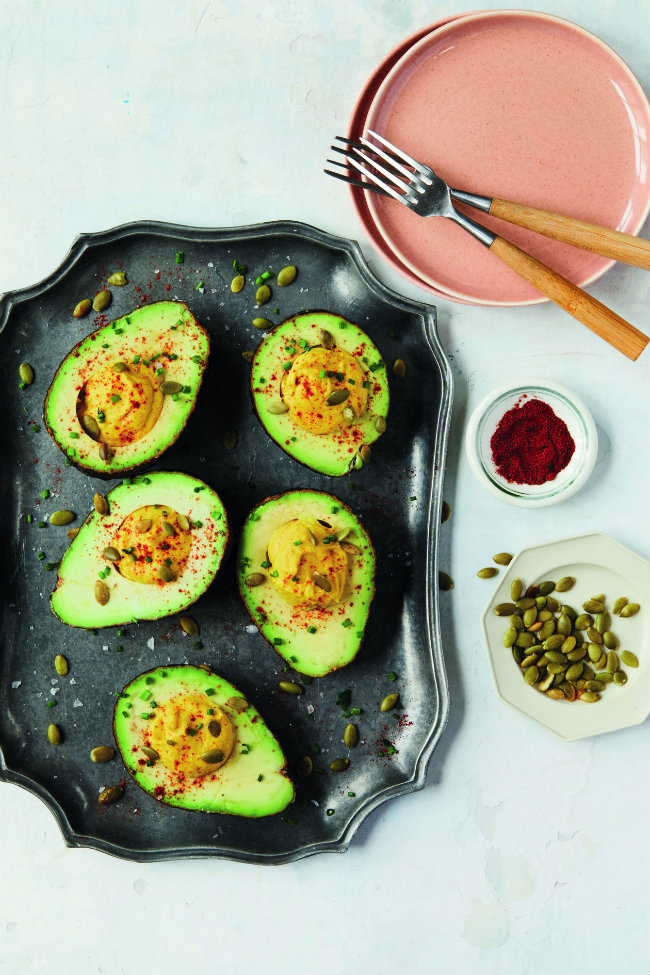
Devilled avocado. Clotilde Dusoulier’s Tasting Paris. Photography © Nicole
Franzen.
Note To use home-cooked chickpeas, you’ll need 11⁄3 cups (240g). Soak 1⁄2 cup (110g) dried chickpeas overnight and cook in a saucepan of boiling water until cooked through and tender, about 1 hour. Drain well.
1 In a food processor, process the chickpeas, tahini, garlic, turmeric, 1 teaspoon salt, the pepper, lemon juice, oil, and 3 tablespoons water until smooth. Add a little more water, tablespoon by tablespoon, as needed until creamy but still scoopable. Taste and add more salt or lemon juice as needed.
2 Scoop 2 rounded tablespoons of hummus into each avocado ‘hole’, as for devilled eggs.
3 Arrange on a serving platter. Sprinkle with the paprika, fleur de sel, squash seeds, and chives.
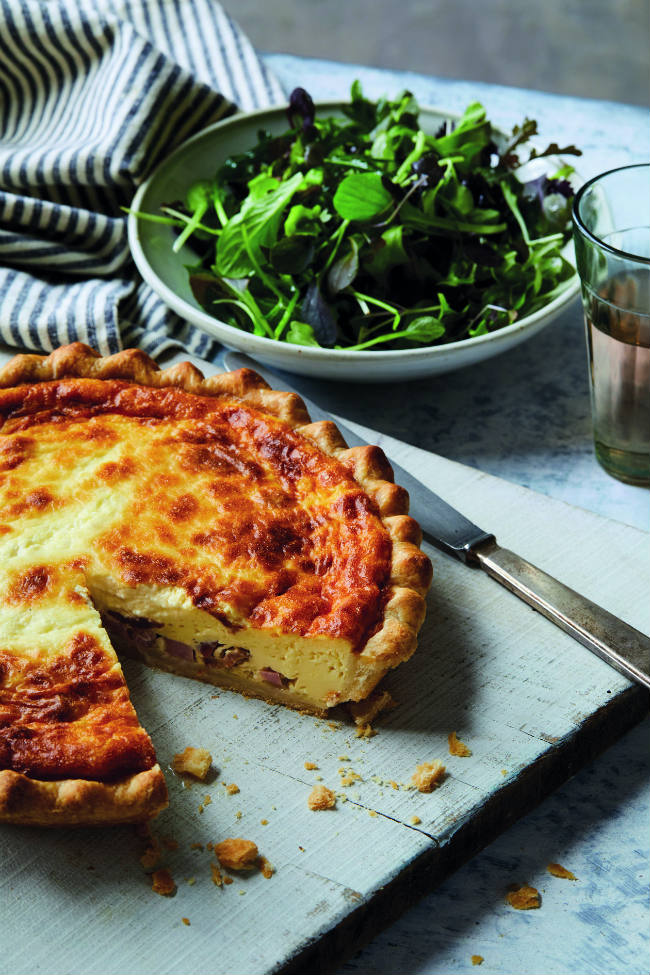
Quiche Lorraine. Clotilde Dusoulier’s Tasting Paris. Photography © Nicole
Franzen.
QUICHE LORRAINE
Classic ham & bacon quiche. Makes one 10-inch (25cm) quiche | Serves 4 to 6
Quiche Lorraine is the most classic of French quiches, and it is ubiquitous in Parisian bakeries and charcuteries. The flaky crust holds a silken custard, rich with the flavour of good eggs and nutmeg, and the savoury, chewy jolts of diced ham and bacon bits – or, really, lardons, short thin strips of pork belly that are a basic punctuation of cooking in the northern half of France. In Paris, you purchase them by weight at the butcher shop and they’ll chop them in front of you as they chat about the neighbour’s cat that ran away. If your local butcher won’t make them, get thick-cut bacon and slice it crosswise into short matchsticks.
Quiche Lorraine makes your house smell divine, or at least like my mother’s kitchen, which is the same thing to me. Invite friends over for lunch on a Sunday and offer this, with a great big bowl of sharply dressed greens, and they may ask to move in with you.
INGREDIENTS
Tart pastry (recipe follows)
5 slices (5 oz/150g) thick-cut bacon, plain or smoked, cut crosswise into short strips
4 large eggs
3⁄4 cup (180ml) crème fraîche or full-fat sour cream
1 1⁄2 cups (360ml) whole milk
1⁄8 teaspoon freshly ground black pepper
1⁄8 teaspoon freshly ground nutmeg
2 oz (55g) thick-cut ham, diced
Mixed greens, lightly dressed with vinaigrette for serving
1 Make the tart pastry and use it to line a 10-inch (25cm) pie or quiche pan.
2 Preheat the oven to 400°F (200°C).
3 Top the dough in the pan with a sheet of parchment paper, add pie weights (or dried beans), and bake for 15 minutes.
4 Meanwhile, in a small dry skillet, fry the bacon strips until just browned, about 10 minutes. Drain. (Keep the rendered fat for another use.)
5 In a medium bowl, beat the eggs lightly with a fork. Gently stir in the crème fraîche, milk, pepper, and nutmeg; avoid beating too much air into the mixture, or the filling will puff up and then crack once baked.
6 Remove the tart shell from the oven and reduce the oven temperature to 300°F (150°C). Lift the parchment paper carefully and remove the pie weights.
7 Scatter the bacon and ham evenly over the tart shell, then slowly pour in the egg mixture without disturbing the bacon and ham. Bake until the filling is golden brown but still a little jiggly in the centre, 50 to 60 minutes.
8 Let set for at least 15 minutes before serving. Enjoy warm, or at room temperature, with
a salad.
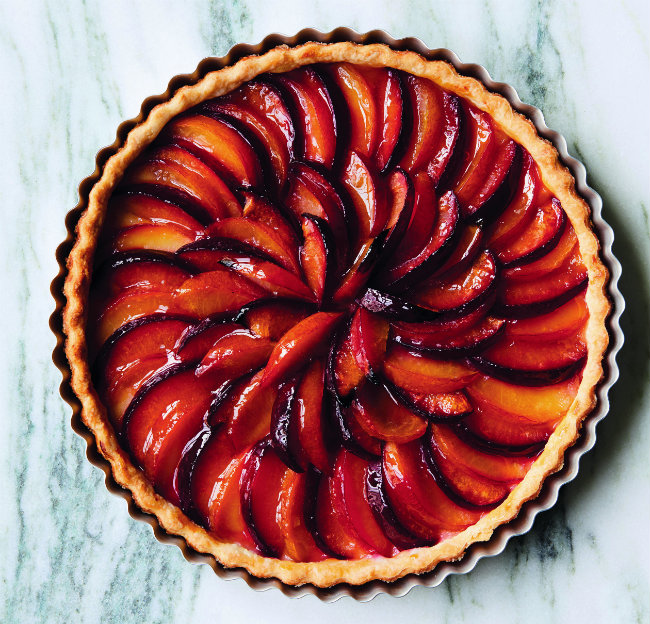
Caramelised plum tart. Quiche Lorraine. Clotilde Dusoulier’s Tasting Paris. Photography © Nicole
Franzen.
CARAMELISED PLUM TART
Tarte aux prunes caramélisée, Serves 8
You may know rue Lepic from the movie Amélie. It is hard to imagine a more charming market street, complete with a cheesemonger, a butcher’s shop, a fish stall, a spice vendor, a charcuterie, a rôtisserie, and more speciality shops than you can shake a baguette at. I showcase it on my tasting tours of Montmartre, and always pause at Les Petits Mitrons (The Baker’s Apprentices). The pink-and-blue pastry shop has stopped passers-by in their tracks since 1982 with its display of fruit tarts arranged on round cooling racks, seemingly straight out of a French grandmother’s oven: perfectly imperfect, with jagged edges and simple patterns of seasonal fruits you would swear were picked from a garden in the back. Even more irresistible than the fruits is the sugar-studded, heavily caramelised, crunchy rim.The secret to this crust is a closely guarded one, but I created a copycat recipe.
I like to make this tart in late summer to show off the rainbow range of French plums: purple quetsches, green reines-claudes, yellow mirabelles. That said, it can be made with any combination of seasonal fruits: berries, figs, cherries, stone fruits, apples, pears . . .
INGREDIENTS
2 teaspoons (10g) unsalted butter
1⁄4 cup (50g) sugar
Tart pastry (see recipe below)
1 3⁄4 pounds (800g) just-ripe, small plums (see Note below)
1⁄4 cup (60ml) apricot jam
1 Grease a 10-inch (25cm) metal tart pan with a removable bottom (see Note) with the butter, and sprinkle the bottom and sides evenly with the sugar. Roll out the pâte brisée and line the pan with it, trimming the excess with a roll of the pin. Let rest for 30 minutes in the refrigerator.
2 Preheat the oven to 425°F (220°C). (If your oven has a mode where the heat comes primarily from the bottom heating element, use this; it will foster a deeper caramelisation of the crust.)
3 Halve and pit the plums. If your plums are very small (1-inch/2.5cm), just leave them as halves; otherwise cut them into quarters or sixths. Arrange the plums skin side down on the dough in a circular pattern, starting from the outside, overlapping slightly; the plums will shrink slightly as they bake. Alternate plum colours if using a mix. Bake for 20 minutes.
4 While the tart is baking, in a small saucepan, heat the apricot jam over low heat. Strain through a fine-mesh sieve into a bowl to remove pieces of skin.
5 Remove the tart from the oven (but leave the oven on). Remove the sides of the tart pan. Using a pastry brush and the strained apricot jam, glaze the sides of the tart, outside and in, and the top of the fruit. Return to the oven until darkly caramelised, 5 to 10 minutes. Transfer to a rack to cool completely.
Note I recommend a metal tart pan with a removable bottom. Metal conducts heat best, and you can expose the sides of the tart in the final baking phase for optimal, Petits Mitrons-like caramelisation. If you don’t have one, the next best thing is a metal tart pan without a removable bottom. I like to use a mix of two or three varieties of plums, if available. You can also use frozen plums straight from the freezer, without thawing.
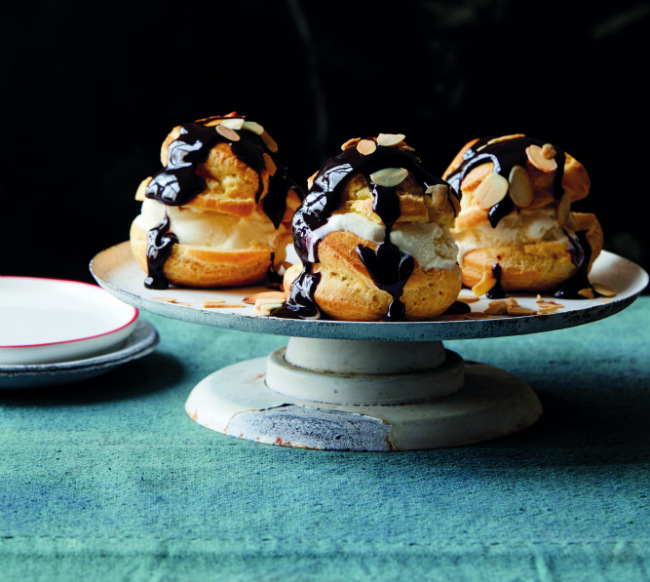
Quiche Lorraine. Clotilde Dusoulier’s Tasting Paris. Photography © Nicole
Franzen.
TART PASTRY
Pâte brisée, Makes enough to line one 10- to 12-inch (25 to 30cm) tart or quiche pan
Let me dispel a myth: French cooks use store-bought crusts, as evidenced by the many options offered in even the smallest Paris supermarkets. However, let me make a case for homemade pâte brisée, the little black dress of pastry, which truly comes together in minutes and elevates baked goods in a way you would not think possible.
INGREDIENTS
7 oz (200g) all-purpose our (about 1 1⁄2 cups), plus more for rolling
1⁄2 teaspoon fine sea salt
7 tablespoons (100g) cold unsalted butter, diced
1 large egg
Ice-cold water, if needed
With a food processor
1 In a food processor, combine the our, salt, and butter. Process for 10 seconds, until you get a bread crumb-like consistency.
2 Add the egg and process for a few more seconds, until the dough comes together into a ball. If the dough seems a little dry, mix in a little ice-cold water, 1 or 2 teaspoons at a time, until the dough does come together.
By hand
1 In a medium bowl, combine the our and salt.
2 Make a well in the centre, add the diced butter and egg, and blend them into the our using a pastry blender or two knives, until you’re able to gather the dough into a ball.
3 If the dough seems a little dry, mix in a little ice-cold water, 1 or 2 teaspoons at a time, until the dough comes together.
In both cases
1 Tip the dough onto a clean work surface and knead lightly for a few seconds. Using a rolling pin and working on a lightly floured surface, roll the dough out and transfer to a greased 10- to 12-inch (25 to 30cm) round tart or quiche pan, pressing it up the sides to adhere. Prick the bottom with a fork.
2 Cover loosely with a kitchen towel and let rest in the fridge for 30 minutes or up to a day before baking or blind-baking.
Note: For sweet uses, you can either roll out the dough in sugar, or sprinkle your buttered pan with sugar. In both cases, the crust will be sugar-studded and irresistibly caramelised.
As seen in France Today magazine
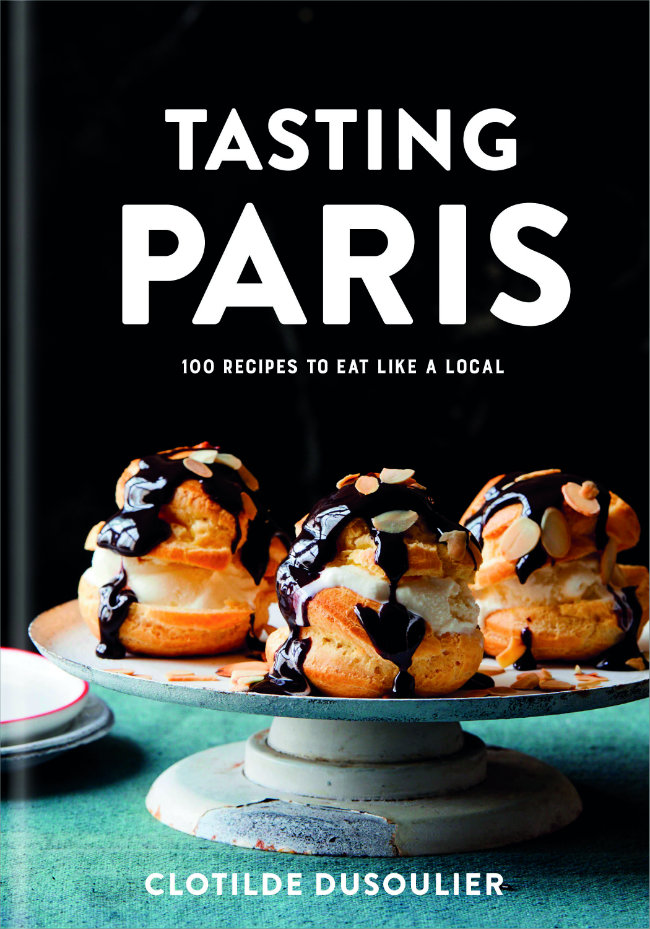
Tasting Paris
Share to: Facebook Twitter LinkedIn Email
Leave a reply
Your email address will not be published. Required fields are marked *



